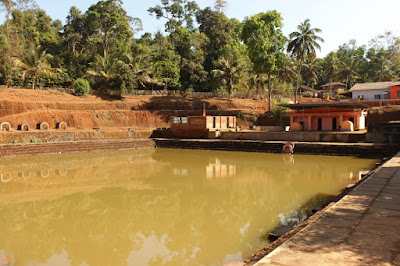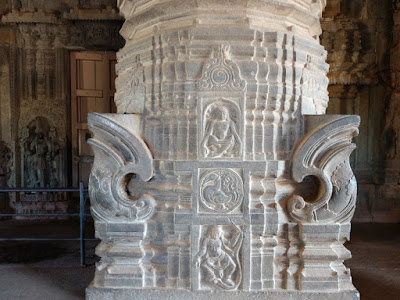A natural washing stone held by the darker rock below.
Nov 28, 2020
few shots of river Beas
A natural washing stone held by the darker rock below.
Nov 21, 2020
Sunnadahalli Anajneya Devastana and Aalaemanae
Sunnadahalli is a small village on the right bank of river Bhadra, near Bhadravathi. Sunnadahalli literally means 'lime village' (Sunna + halli). Probably the village was known for lime production. I've known this village since my childhood days when we lived in Bhadravathi. We used to go walking from our home in MPM Colony to Sunnadahalli Anjaneya temple. A foot bridge connected the two banks. I used to be scared while crossing the bridge when the water level was high. Often the bridge would remain submerged for days. Apart from casual walks, we went to the river during Ganesha Habba. Colony people sent their Ganeshas away in river Bhadra.
Farmers in and around Sunnadahalli grew mostly paddy and sugarcane. The latter was fed to sugar mills or to Aalaemane (jaggery production unit). I remember seeing one Aalaemanae, a bright red glow was visible from a kilometer.
Pushpa and I stayed overnight at Bhadravathi while traveling from Dharwad to Bangalore via Sirsi.
February 23, 2020
Bhadravathi to Sunnadahalli is around four kilometers. We reached the village by 7-40 am. This is the arch across the village entrance.
The temple wasn't open. A hand written board said it opened at 9-00 AM. I was surprised and amused, temple opening like an office. Anyway, we did Namaskara to the temple and left. The place had changed over the years. A big ficus tree dominated the village square and there used to be lot of monkeys. The trees gone, so are the monkeys. In a way, this village has lost its charm.
At the village entrance was a Aalaemanae. On the way out, I suggested we see it. Pushpa was seeing one first time. The cane crusher was not running at that moment but the large pan of sugarcane juice was boiling on the stove fueled by bagasse.
The landlord of this mill is a local man, he was away on some work. His workers monitored the pan.. the liquid needs to stirred every few minutes and the fire needs to be fed. The white material on the floor is bagasse, the fibrous residue of sugarcane after the juice is extracted. After crushing, bagasse is dried & stacked for future use.
Sugarcane juice is boiled for eight hours continuously so that it loses water and becomes a thick liquid jaggery. Next to the pan is a special floor, lined with stone slabs. The pan is hoisted using a chain pulley and pour the hot liquid jaggery on to the floor. The thick liquid is allowed to cool naturally and solidify. The workers make small cakes or blocks for retail sale.
One batch- crushing, boiling and cooling -runs upto 24 hours. The workers man the operation is shifts. These people spoke Hindi, their Kannada was broken. They seems to be immigrants form up north.
Bagasse stack, looks like last year's stock. New bagasse is being dried on the side. The workers gifted us a small cake of dark brown jaggery.
The short stopover was nice. As we turned in to the highway, I noticed this stone slab with the village's name inscribed on it. May the inscription remain as is for a long time to come.
.........Nov 14, 2020
Varadamoola
Just like Shalmala Ugamasthala near Dharwad, Varadamoola also has a tank where water from the source collects and then starts its journey.
Varada is a tributary of Tungabhadra. From here it flows past Chandragutti, Banavasi, intersects with NH47 midway between Haveri and Bankapur, flows past Havanur fort and merges with Tungabhadra close to Galaganatha in Haveri district.
Having started our journey early morning, we were kind of tired and it was sunny. So we didn't really bother to explore all the temples here. As we climbed back the steps to the road, I noticed a strange looking stone sculpture. It looked like a Tamburi (Tampura). I went back to check out the sculpture closely.
This is the monolith sculpture measuring approximately six feet long. As you it is elliptical at one end, symmetrical and has two projections on either sides. With the divider, this device has two separate channels with four exit points. I feel this is some type of device used during religious rituals. I checked with my friends and received some responses-
- probably a music instrument which uses water
- looks like a feeder unit for large animals, elephants may before
- used to pour ghee into the fire during Homa
- Most probably a device to allow Abhisheka water to flow outside
- it perfectly looks like Morsing, a percussion instrument
- looks like Pani Peetha of a Shivalinga or rain catcher..
Our plan was to reach Bhadravathi before sunset. I avoid driving into the night. so we left without delay. We drove non-stop, checked into a hotel and went out for a drive to MPM colony. I showed Pushpa our colony, our street, our house, even the factory entrance. Our day ended with snacks and tea at the open food court opposite Mary Immaculate Church.
.........
Nov 7, 2020
Ikkeri Aghoreshvara Devastana - part 3
In the first and second parts of this article, the temple's exterior and perforated windows from the inside were covered. Now, I'm in the Mukhamantapa, the pillared hall of this temple. Behind these doors are Ardhamandapa and Garbhagriha. The seven layered door frame is ornate, its a grand one. Despite the grandness of this temple, the choice of raw material (stone) in this temple is questionable. The texture is not consistent. Probably it was consistent during the time of construction, something changed later on. Or it be a recent happening.. result of chemical treatment.
This is the four pillared central Mantapa within the Mukhamandapa. It's a stage for meetings or dance performance. The columns are heavy and ornate. The base of the columns is square section, the four faces are plain. There weren't any inscription on it. May be it was kept blank for future sculptors to exhibit their skill.
The central Manatapa's ceiling. A matrix of nine lotus. The way the nine lotus are separated is clever. Mid-April I received a puzzle in one of my Whatsapp groups. The puzzle was to quarantine nine dogs (arranged in 3x3 matrix) using two squares. One of the members drew two squares exactly as shown here. What a coincidence!
Apart from the nine lotuses, the ceiling has not other ornamentation. Lets take a look at some of the columns. The bottom most figure is the scene of Krishna slaying Aghasura the demon. Aghasura had taken the form of an enormous serpent. Krishna's friends, the cowherd boys, entered Aghasura's mouth mistaking it for a cavern. Krishna rescued the boys and slayed Aghasura. The bird in the middle must be a peacock. The image of a man with rope around his legs and torso seems to be performing a Aasana.
Another pillar with Krishna slaying Aghasura and squatting man with rope. The columns' corners are carved into a complex set of curves. Every column is hall has such carvings.The bottom figure is a man dancing gleefully. He seems to be holding some musical instrument in his hands.
Here we have a monkey eating some round object, a peacock and squatting Ganesha. The corner carvings are slightly more complex compared the previous picture.
The corner carvings depicts an imaginary creature, its jaws apart and teeth exposed. The column face has two figurines- one male and one female. The man is playing a stringed musical instrument like a Veena, only the gourd is missing. The well built woman is holding a mace, she must be a warrior. The woman is flanked by two lions.
Here we have a long flat face with a niche at its bottom. Inside the nice is a well built woman holding a baby in her left hand. The image is disproportionate.. her left feet is oversize. The female character could be Poothani (Putana) the female demon who killed infants.
This column features a wheel.. it could be a lotus or Sudharshana Chakra. The woman at the top is holding a yak-hair fan, the type used in temples and Mathas. The bottom figure is a young boy playing a drum. He looks like Krishna.
This column features a long floral strip. The corner carvings are asymmetrical here. There's a difference in the curvature lengths. Below the corner carvings, on both sides are vertical strips with repetitive shapes. Its a nice touch.
Another column with floral ornamentation. Comparing this picture to the previous one, there's a difference in the radii of the curvatures. Wondering if this inconsistency is real or only in the images.
One of the columns featured this image- three parrots entangled into a tight circle. Each of the columns have many interesting images, brilliant patterns and designs. To see all one will need hald a day. With this our tour of the main shrine comes to an end.
This is the sub-shrine besides the main temple, dedicated to Parvati, In plan, Aghoreshwara temple is 35 meters long x 19 meters wide and Parvati temple 12 meters long x 7.5 meters wide. The Nandi inside the Mantapa is positioned in such a way that it's left eye is aimed at Aghoreshwara and its right eye is towards Parvati.
This is Parvati temple's Garbhagudi gutter. This is a beautiful piece, very graceful. Because of its color, it looks like cast iron. In ancient times, the pooja water and milk used to be consumed as Theertha by people and cattle. The collection used to be well maintained so that Theerta is fit for consumption. However, in the present time, that's not the case. Some places the liquid stays stagnant for days, decomposing and giving out foul stink. Temple priests must ensure holy/sacred water isn't wasted. At least it should be let off to plants.
We were done with Ikkeri Aghoreshwara Devatsana. Before we leave, lets take a quick look at this small tower besides the temple gate. This structure is made of laterite blocks, its top surface is covered with stone slabs. There could be a well at the center or may be this is just a small tower.
With the sun beating down, we did not want to stand here any more than required. We headed back to the car, washed my arms and face and resumed out journey.
.........


















































